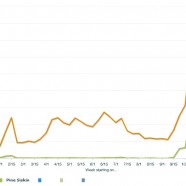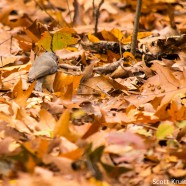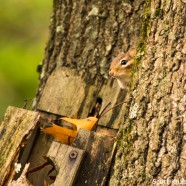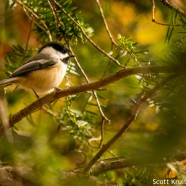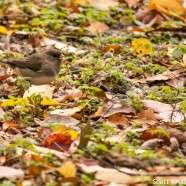Purple Finch and Pine Siskin invasion
Two species have recently flooded the Northeast and Mid-Atlantic according to list serv reports, accounts from friends and my own personal observations – the Purple Finch and the Pine Siskin. The former has been unbelievably abundant in my experience, often being difficult to go outside for any length of time without seeing one in the past month. The latter, while a bit tougher to spot, has nonetheless zipped by in sizable groups and maintained their nomadic feeding habits. Just how massive are these irruptions in our region? I turned to eBird to find out the truth. Here are both...
Read MoreTufted Titmouse digging in leaf litter
Can you identify this bird with its back to us? The Tufted Titmouse (Baeolophus bicolor) does not have legs and feet specifically designed to scratch at the earth that many sparrows possess. Even if it did they would have a tough time getting through these layers of leaves. This bird was ripping away with its bill, leaf by leaf, sifting through them to find some food. It was an organized, frantic and impressively strong leaf tossing frenzy. Good hunting, little one!
Read MoreEastern Chipmunk (Tamias striatus) saying hello
Oh, hello there, Eastern Chipmunk (Tamias striatus). It seems as if there is nothing to see here, yes? The poor little thing was frozen in place while we had a staring contest. I was the first one who blinked, moving ever so slightly, and it dashed back off behind the tree. I hope it did not think it was invisible until then. Either way it was a very cute moment in November nature. I wish it the best for winter season and hope it has a large cache of food to snack on between naps. Scott Kruitbosch Conservation & Outreach Coordinator
Read MoreBlack-capped Chickadee (Poecile atricapillus) irruption
There have been Black-capped Chickadees (Poecile atricapillus) moving south in very subtle ways for a couple of months now. If you watch migratory hotspots you can sometimes detect their irruption years, especially if that location is not a particularly friendly habitat for the species. I have seen flocks of 10-20 birds tightly packed together and feeding on the move, possibly heading for a feeding station like yours. I always wonder what particular triggers end up notifying a widespread and highly adaptive bird like this one that they should nonetheless change their quarters for the autumn...
Read MoreExtremely abundant common sparrows
This Dark-eyed Junco can be seen chowing down on a seed while nearly 200 more of its friends were doing the same nearby. I cannot recall a time where I have seen a greater sustained abundance, perhaps for the last three or four weeks, of a few common sparrow species spread across the region. There have been huge flocks of Song Sparrows, Dark-eyed Juncos, and White-throated Sparrows seemingly everywhere in appropriate habitat. Have you noticed the same? Maybe they had a very productive nesting year and perhaps they are also irrupting due to a lack of food in the north. Thankfully there is no...
Read More



